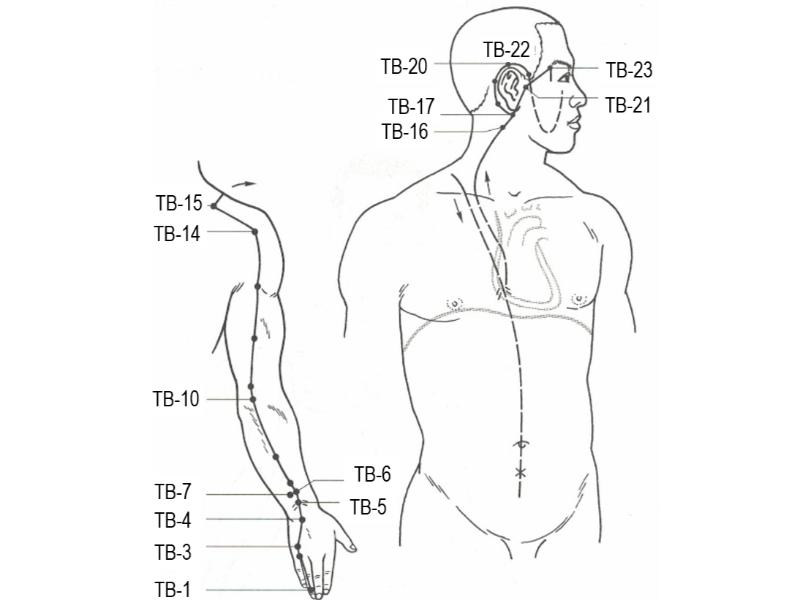Search in dictionary
Hand lesser yáng (shào yáng) triple burner channel
手少阳三焦经 〔手少陽三焦經〕 shǒu shào yáng sān jiāo jīng
Abbreviation: TB. One of the twelve channels.
 |
| Hand lesser yáng (shào yáng) triple burner channel |
|---|
Connections
PC → TB → GB; homes to the triple burner; nets the pericardium.
Triple Burner Channel Pathway
Overview
Ulnar side of tip of fourth finger → ulnar aspect of dorsum of hand → midline of arm → over shoulder → supraclavicular fossa → submerges to net pericardium → homes to all three burners.- Branch (2):
Chest center → supraclavicular fossa → over shoulder → GV-14 → nape → skirts ear. - Secondary branch (2):
Behind ear → intersects with main branch → outer canthus (GB-1) → GB.
Description
The hand lesser yáng (shào yáng) triple burner channel starts at the ulnar side of the tip of the fourth (ring) finger (TB-1, guān chōng, Passage Hub), and ascends the ulnar aspect of the fourth finger, the ulnar aspect of the fourth metacarpal bone on the dorsum of the hand, to the outside of the wrist. Proceeding up the posterior midline of the forearm between the radius and the ulna, it runs over the tip of the elbow (olecranon), and then travels up the posterior midline of the upper arm to the shoulder. It crosses back over the shoulder before running into the supraclavicular fossa (ST-12, quē pén, Empty Basin), where it submerges and spreads into the chest center to net the pericardium and then descends internally, homing through each of the three burners successively.
A branch breaks off from the chest center
(膻中 dàn zhōng, central region of the chest after which CV-17 is named), rises to emerge in the supraclavicular fossa, then runs over the shoulder to GV-14 (dà zhuī, Great Hammer), where the right and left pathways intersect with the governing vessel. It then runs up the nape to the depression behind the lower tip of the ear (TB-17, yì fēng, Wind Screen), from where it skirts the ear to its upper tip, dips downward under the cheek before ascending to below the eye.
A secondary branch separates behind the ear, enters the ear to reemerge in front of it, then crosses in front of the foot lesser yáng (shào yáng) gallbladder channel at GB-3 (shàng guān, Upper Gate) and intersects with the main branch, to terminate at the outer canthus (GB-1, tóng zǐ liáo, Pupil Bone-Hole), where it meets the lesser yáng (shào yáng) gallbladder channel.
Triple Burner Channel Acupoints
Indications of TB Acupoints
The 23 points on the hand lesser yáng (shào yáng) triple burner channel treat diseases of the head, ears, eyes, throat, chest, and rib-side, and externally contracted febrile disease, and other conditions in areas traversed by the channel.
- Head, ears, eyes, throat: Deafness, tinnitus, painful red swollen eyes, painful swollen throat, swelling of the cheeks.
- Internal course: Abdominal distension, water swelling, enuresis, and inhibited urination, though associated with the triple burner, are not treated through TB points.
- External pathway: Pain behind the ear or on the lateral aspect of the shoulder or upper arm; scrofula.
Major TB Acupoints
TB-2 (液门 yè mén, Humor Gate): Located on the dorsal aspect of the hand, proximal to the margin of the web between the fourth and fifth fingers, level with the metacarpophalangeal (mcp) articulation of the fourth finger.
- Indications: Headache; red eyes; deafness; painful swollen throat; malarial disease; pain in the arm and hand.
- Stimulus: Needling: 0.2–0.5 cùn perpendicular insertion. Moxa: 3 cones; pole 5–10 min.
- Categories: Spring (yíng) (water) point.
| Indications for TB Points |
|---|
|
TB-5 (外关 wài guān, Outer Pass): Located on the posterior aspect of the forearm, 2 cùn proximal to the wrist, midway between the radius and the ulna.
- Indications: Febrile disease; headache; painful red swollen eyes; deafness; tinnitus; scrofula; pain in the cheek; rib-side pain; impediment pain in the upper limbs with inhibited bending and stretching of the arm; pain in the fingers; tremor of the hand.
- Stimulus: Needling: 0.3–1. 0 cùn perpendicular insertion. Moxa: 2–3 cones; pole 5–15 min.
- Categories: Network point (luò xué); confluence point (bā mài jiāo huì xué) of the yáng linking vessel (yáng wéi mài).
TB-6 (支沟 zhī gōu, Branch Ditch): Located on the posterior aspect of the forearm, 3 cùn proximal to the wrist, midway between the radius and the ulna.
- Indications: Tinnitus; deafness; fulminant loss of voice; scrofula; rib-side pain; constipation; febrile disease.
- Stimulus: Needling: 0.7–1. 0 cùn perpendicular insertion. Moxa: 3–5 cones; pole 5–15 min.
- Categories: River (jīng) (fire) point.
TB-8 (三阳络 sān yáng luò, Three Yáng Connection): Located on the posterior aspect of the forearm, 4 cùn proximal to the wrist, midway between the radius and the ulna.
- Indications: Deafness; fulminant loss of voice; toothache; impediment pain in the upper limbs.
- Stimulus: Moxa: 5–7 cones; pole 5–20 min.
- Warning: Though needling has been traditionally contraindicated for this point, TB-8 in has recent years been combined with (joined by a single needle to) PC-4 in acuanesthesia for removal of pulmonary lobes.